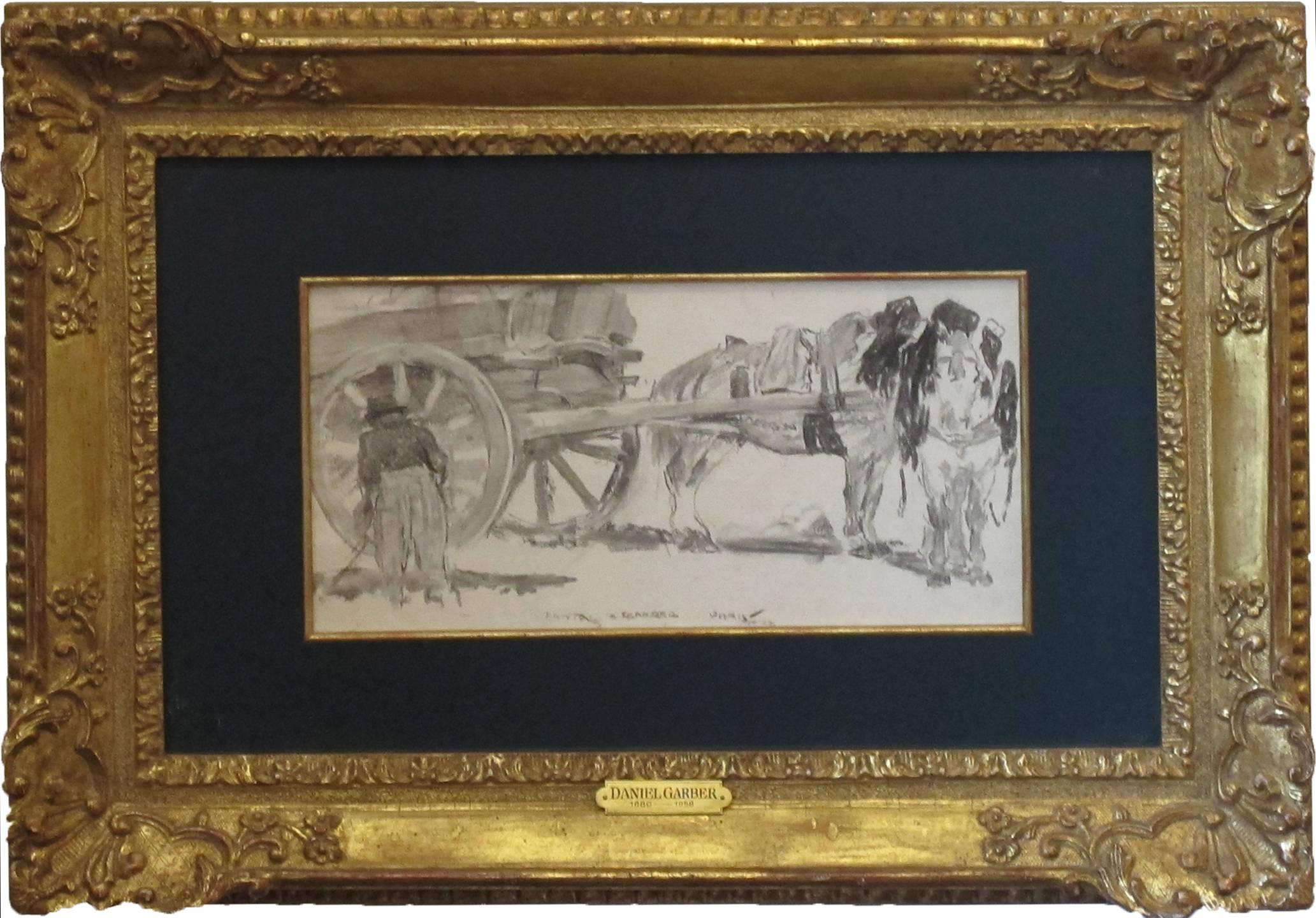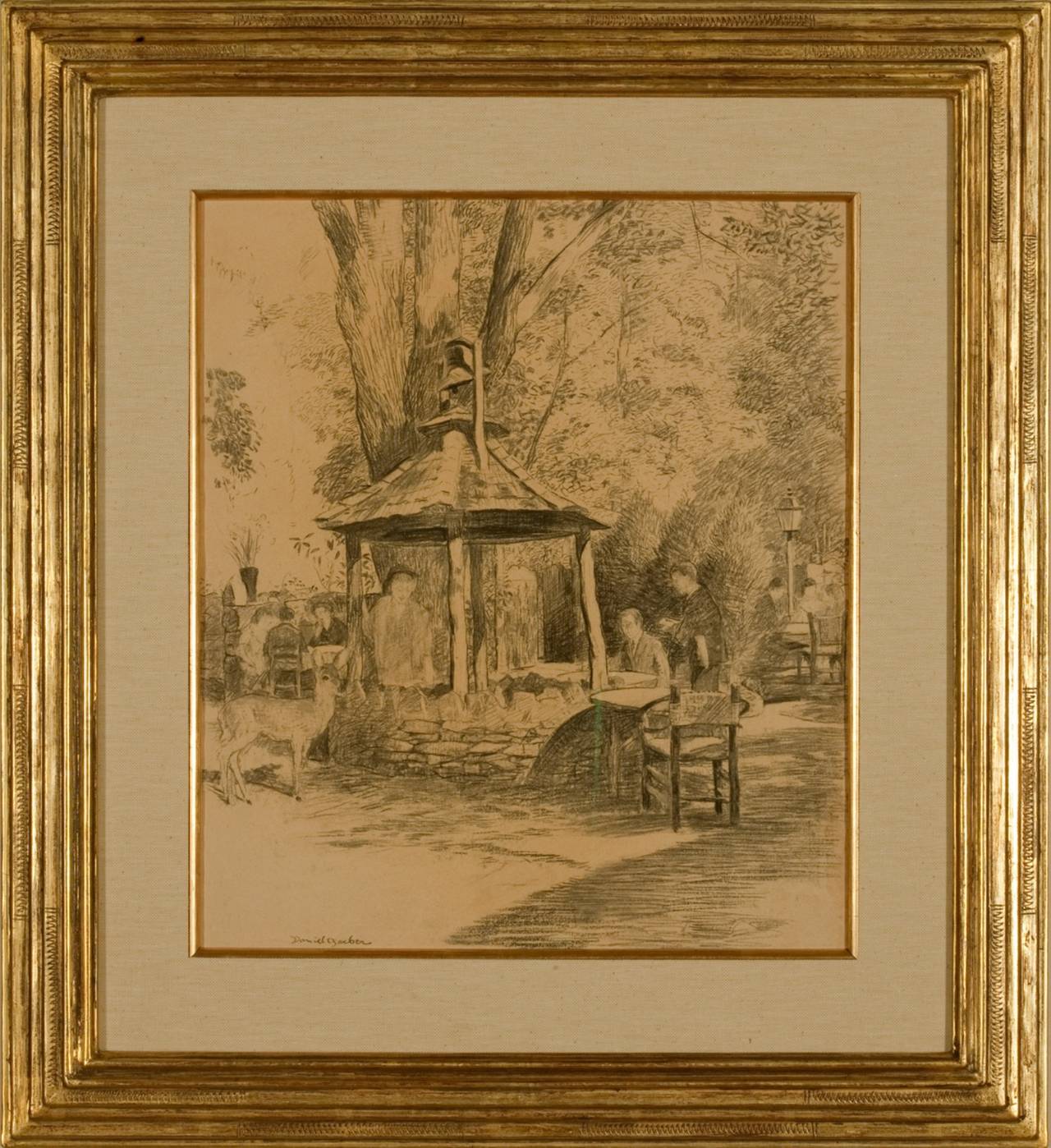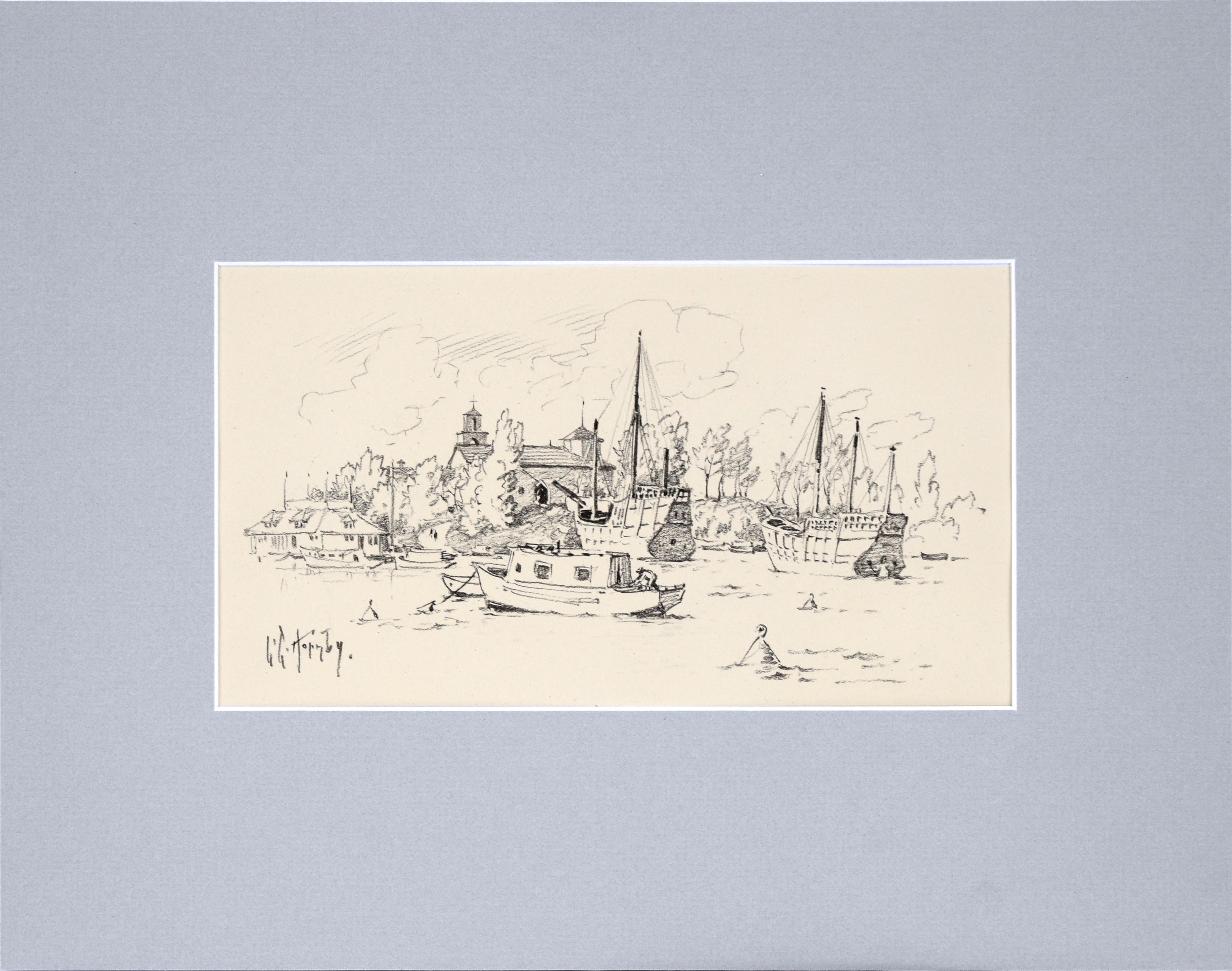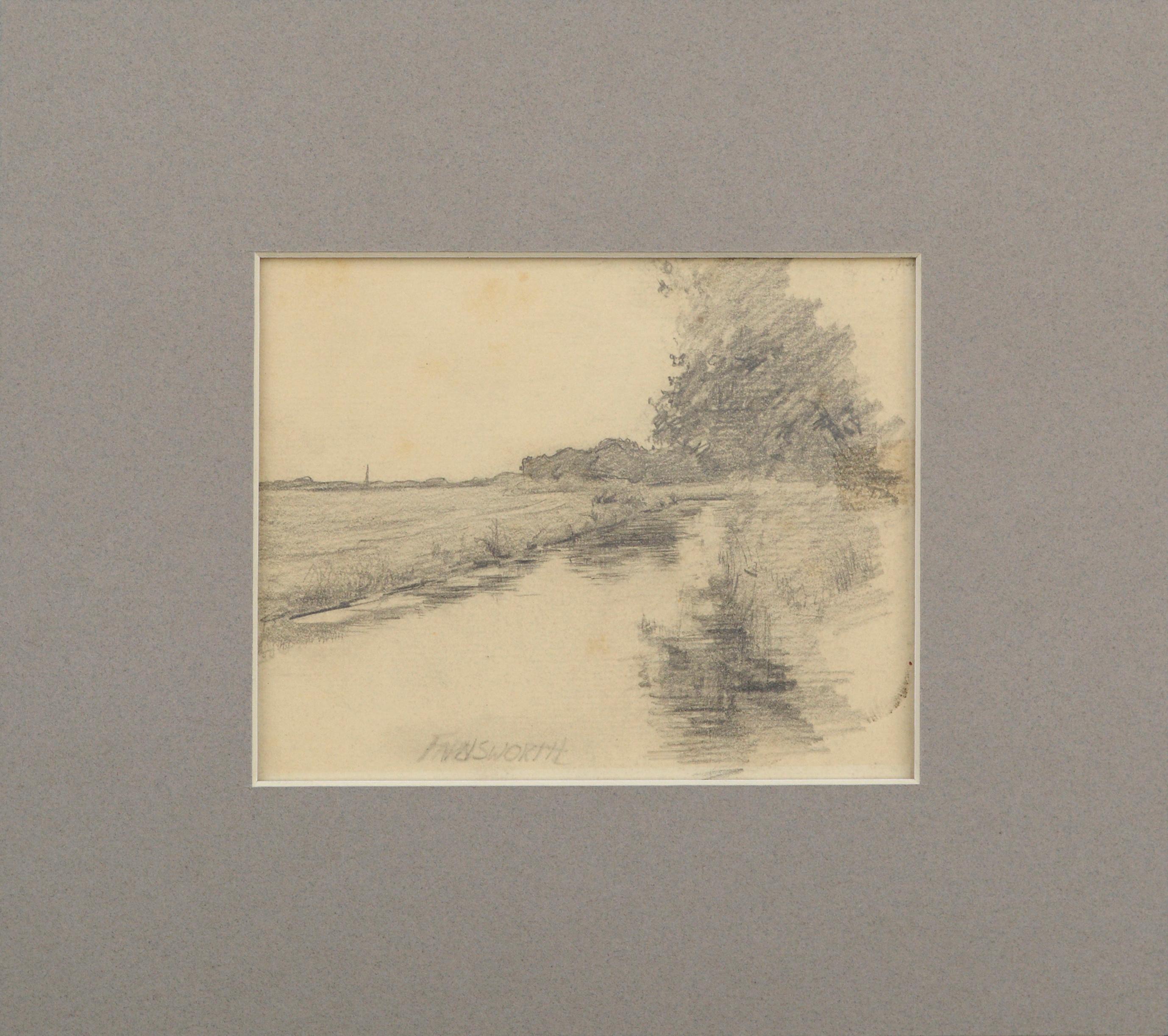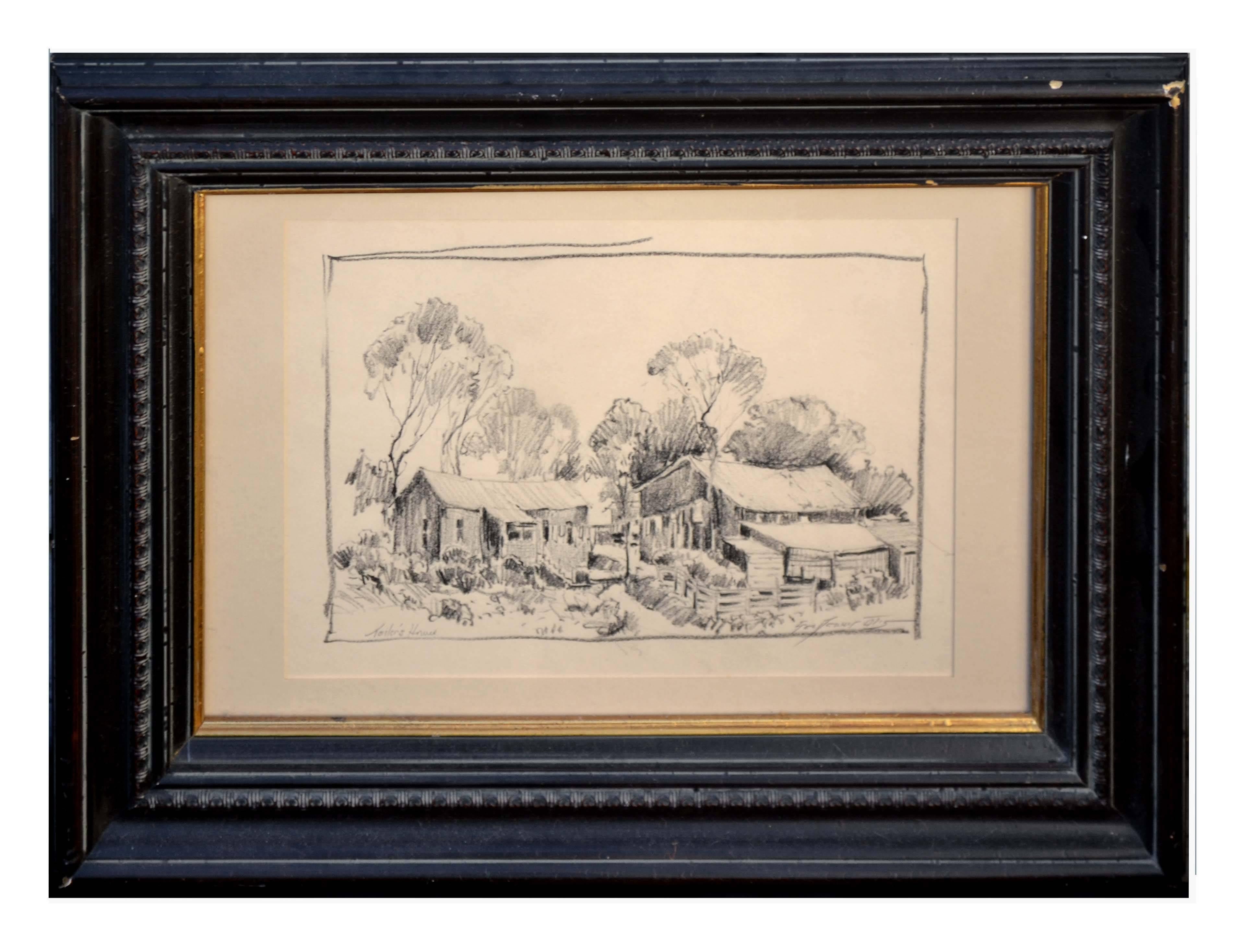Items Similar to Morning Near Arizona, 1880s Summer Southwestern Desert Landscape Drawing
Video Loading
Want more images or videos?
Request additional images or videos from the seller
1 of 17
George Elbert BurrMorning Near Arizona, 1880s Summer Southwestern Desert Landscape Drawing1888
1888
About the Item
Morning Near Arizona, (Desert Landscape) is an original color pencil drawing from 1888 by George Elbert Burr (1859-1939). Portrays a spring/summer landscape with a tree and fauna, clouds, a mountain peak in the distance. Presented in a custom frame with archival mat and UV protectant glass, outer dimensions measure 17 x 20 ¼ inches. Image size is 10 x 13 ¼ inches.
Provenance: Private Collection, Denver, Colorado
Drawing is in good condition - please contact us for a detailed condition report.
About the Artist:
Born 1859
Died 1939
Ten years after his birth in Monroe Falls, Ohio, George Elbert Burr moved with his parents to Cameron, Missouri, where his father opened a hardware store. Burr was interested in art from an early age and his first etchings were created with the use of zinc scraps found in the spark pan under the kitchen stove. He then printed the plates on a press located in the tin shop of his father’s store.
In December of 1878, Burr left for Illinois to attend the Art Institute of Chicago (then called the Chicago Academy of Design). By April of the following year, Burr had moved back to Cameron. The few months of study in Chicago constituted the only formal training the artist was to have.
Back in Missouri, Burr heeded his family’s wishes by working in his father’s store. However, he did not abandon his art, often using his father’s railway pass to travel around the countryside on sketching trips. In 1894, Burr married Elizabeth Rogers and the following year he became an instructor for a local drawing class.
By 1888, the artist was employed as an illustrator for Scribner’s, Harper’s, and The Observer. During that time, his illustrations were also published in Volume II of John Muir’s Picturesque California. In December of the same year, Burr relocated to New York City for several months to work on assignment for The Observer. Over the next several years, Burr worked and traveled extensively as an illustrator contributing to additional periodicals including The Cosmopolitan and Leslie’s Illustrated Newspaper.
In 1892, Burr began a four-year project to illustrate a catalog for the Metropolitan Museum of Art of Heber R. Bishop’s jade collection. After completing approximately 1,000 etchings of the collection, Burr used the money he earned on the project to fund a trip abroad. The artist and his wife spent the years between 1896 and 1901 sketching and traveling on a tour of Europe that spanned from Sicily to North Wales. After their return from Europe, the Burr’s settled in New Jersey where Burr sustained a living through the sale of his etchings and watercolors. During the next few years, Burr’s watercolors were displayed in galleries and exhibitions along the east coast and as far west as Kansas City, Missouri.
In 1906 the couple moved to Denver, Colorado, in an effort to improve George’s poor health. While in Colorado, Burr completed Mountain Moods, a series of 16 etchings.
His years in Denver were highly productive despite his poor health. He gained membership to art organizations including the New York Society of Etchers and the Brooklyn Society of Etchers (later renamed Society of American Etchers). Burr’s winters were spent traveling through the deserts of Southern California, Arizona, and New Mexico. In 1921, Burr obtained copyrights on the last of 35 etchings included in his well-known Desert Set.
Burr’s failing health prompted a move to a more moderate climate and the couple settled in Phoenix, Arizona, in 1924. In Phoenix, Burr served as president of the Phoenix Fine Arts Association and participated in the city’s first major art exhibition. Burr remained in Phoenix until his death in 1939.
Throughout his lifetime Burr worked in a variety of mediums creating approximately fifty oil paintings, over a thousand watercolors, two-thousand pen-and-ink drawings and over twenty-five thousand etchings all pulled from his own presses.
“I first etch the plate in line as for an ordinary black-and-white etching, and after taking a proof, I apply ground to the plate with resin powder and then etch in aquatint for the different colors and tones; or I first start the plate with soft-ground etching and afterward finish with aquatint. After the plate is properly etched, I then paint the picture on the copper with ordinary oil colors, removing carefully all color that does not adhere to the granulated surface, and then print on moistened sheet of Japan paper in ordinary etching press. By this method each print is a distinct picture, each proof requiring a separate painting on the copper, no two being alike, the pictures varying according to the mood and will of the artist. The process is a slow one and I make a very limited number of proofs and then destroy the plate, by that means giving added value to the few prints that I place before the public.” –George Elbert Burr on the printmaking process.
Exhibitions: Boston Art Club, 1902, 1906; Art Institute of Chicago, 1910, 1913; National Museum of American Art, 1986 (retrospective); Mitchell Brown Gallery, Tucson, Arizona, 1990 (retrospective).
Works Held: Art Institute of Chicago; Boston Museum of Fine Arts; Brooklyn Museum; Carnegie Institute; City Museum, St. Louis; Cleveland Museum of Art; Colorado State University; Denver Art Museum; Detroit Institute; Fine Arts Gallery, San Diego, California; Fogg Art Museum, Cambridge, Massachusetts; Library of Congress; Los Angeles County Museum of Art; Metropolitan Museum of Art; New York Public Library; Newark Museum; Phoenix Fine Arts Association; Prints of the Year, 1931; Public Library, Santa Barbara; Toledo Museum of Art; Berlin; Luxembourg, Paris; Bibliothéque Nationale, Paris; Victoria and Albert Museum, British Museum, London.
Further Reading: American Etchers, Vol. 7, George Elbert Burr with a foreward by Arthur Millier, the Crafton Collection, New York, 1930.; George Elbert Burr 1859-1939: Catalogue Raisonne and Guide to the Etched Works with Biographical and Critical Notes, Louise Combes Seeber, Northland Press, Flagstaff, Arizona,1971.; The Illustrated Biographical Encyclopedia of Artists of the American West, Peggy and Harold Samuels, Doubleday & Company, Inc., Garden City, New York, 1976.; Who Was Who in American Art 1564-1975: 400 Years of Artists in America, Vol. 1. Peter Hastings Falk, Georgia Kuchen and Veronica Roessler, eds., Sound View Press, Madison, Connecticut, 1999. 3 Vols.
©David Cook Galleries, LLC
- Creator:George Elbert Burr (1859 - 1939, American)
- Creation Year:1888
- Dimensions:Height: 17 in (43.18 cm)Width: 20.25 in (51.44 cm)Depth: 1 in (2.54 cm)
- Medium:
- Movement & Style:
- Period:
- Framing:Frame IncludedFraming Options Available
- Condition:very good vintage condition.
- Gallery Location:Denver, CO
- Reference Number:
About the Seller
5.0
Platinum Seller
These expertly vetted sellers are 1stDibs' most experienced sellers and are rated highest by our customers.
Established in 1979
1stDibs seller since 2013
264 sales on 1stDibs
Typical response time: 5 hours
- ShippingRetrieving quote...Ships From: Denver, CO
- Return PolicyA return for this item may be initiated within 7 days of delivery.
More From This SellerView All
- Colorado Ranch Summer Landscape Painting, 1940s Landscape WatercolorBy Irene D. FowlerLocated in Denver, COOriginal western landscape painting of trees near a ranch in Colorado by Irene Fowler, one of Colorado's preeminent women artists of the 20th century. Presented in a custom frame, outer dimensions measure 17 ½ x 23 ½ x 1 ½ inches. Image size is 11 ½ x 17 ¼ inches. Painting is clean and in very good vintage condition - please contact us for a detailed condition report. Expedited and international shipping is available - please contact us for a quote. About the Artist: An important figure in the development of Denver as an artistic city, Irene Fowler was a public school teacher and founding member of the Denver Artist’s Guild (now the Colorado Artist’s Guild) in addition to being a prolific artist. She exhibited in Denver at the Schlier Gallery (where she had a solo exhibition), at the Chappell House, the University Club...Category
Mid-20th Century American Impressionist Landscape Drawings and Watercolors
MaterialsWatercolor
- Mountain Ranch, Modern Summer Colorado Mountain Landscape, Watercolor PaintingBy Irene D. FowlerLocated in Denver, COOriginal signed watercolor painting of a ranch in the Colorado mountains in springtime or summer coloring of green, blue, yellow, white and brown by Denver artist, Irene Fowler. Presented in a custom frame with all archival materials, outer dimensions measure 17 ½ x 23 ½ x 1 ½ inches. Image size is 12 x 18 inches. About the Artist: An important figure in the development of Denver as an artistic city, Irene Fowler was a public school teacher and founding member of the Denver Artist’s Guild (now the Colorado Artist’s Guild) in addition to being a prolific artist. She exhibited in Denver at the Schlier Gallery (where she had a solo exhibition), at the Chappell House, the University Club, and the Broadmoor Art Gallery in Colorado Springs. In 1950-1952 she served as president of the Denver Artist’s Guild. Fowler painted in oil or watercolor and her paintings were almost exclusively done en plein air. Her landscapes of Colorado...Category
Mid-20th Century American Impressionist Landscape Drawings and Watercolors
MaterialsWatercolor
- Silver Plume, Colorado, Framed Colorado Mountain Landscape Oil Pastel DrawingBy Elsie Haddon HaynesLocated in Denver, COSilver Plume, Colorado - near Georgetown, mountain landscape with fall colors, Aspen and Pine trees, river, houses and mountains by early 20th century Co...Category
1930s American Impressionist Landscape Drawings and Watercolors
MaterialsOil Pastel, Pastel
- Sangre de Cristo Mountains, Southern Colorado Watercolor Landscape PaintingBy Alfred WandsLocated in Denver, COVintage original modernist watercolor painting of the Sangre de Cristo Mountain range in Colorado by Alfred Wands (1904-1998). A farm in th...Category
20th Century American Impressionist Landscape Paintings
MaterialsWatercolor
- California Coast Landscape Marine Painting, Watercolor Painting Rocks, WavesBy Charles Partridge AdamsLocated in Denver, COCalifornia coastal painting by early 20th century artist, Charles Partridge Adams circa 1925. Watercolor on paper, not signed, attributed ...Category
1920s American Impressionist Landscape Paintings
MaterialsWatercolor
- Vintage Colorado Mountain Landscape, Original Framed Modernist Graphite DrawingBy Boardman RobinsonLocated in Denver, COOriginal graphite on paper drawing by Boardman Robinson depicting a Colorado mountain landscape. Signed by the artist lower right with an ...Category
20th Century American Modern Landscape Drawings and Watercolors
MaterialsPaper, Graphite
You May Also Like
- "Central Park"By William Langson LathropLocated in Lambertville, NJJim’s of Lambertville is proud to offer this artwork. Signed. Complemented by a hand carved and gilt frame. William L. Lathrop (1859-1938) Deemed “Father of the New Hope Art Colony”, William Langson Lathrop was born in Warren, Illinois. He was largely self-taught, having only studied briefly with William Merritt Chase in 1887, at the Art Students League. Lathrop first moved east in the early 1880s, and took a job at the Photoengraving Company in New York City. While there, he befriended a fellow employee, Henry B. Snell. The two men became lifelong friends and ultimately, both would be considered central figures among the New Hope Art Colony. Lathrop's early years as an artist were ones of continuing struggle. His efforts to break through in the New York art scene seemed futile, so he scraped enough money together to travel to Europe with Henry Snell in1888. There he met and married an English girl, Annie Burt. Upon returning to New York, he tried his hand at etching, making tools from old saw blades. Even though his prints were extremely beautiful, he still was impoverished. Lathrop would return to his family in Ohio, before once again attempting the New York art scene. In 1899, with great trepidation, he submitted five small watercolors to an exhibit at the New York Watercolor Club. He won the Evans Prize, the only award given, and four of the five paintings were sold the opening night. At age forty Lathrop’s career would finally take off and he became an “overnight success Lathrop came to Phillips Mill for the first time in1898, to visit his boyhood friend, Dr. George Marshall. Shortly after, he and his family purchased the old miller’s house from Dr. Marshall. The Lathrop’s home became a social and artistic center for the growing New Hope colony. Tea and fascinating conversation was the “order of the day” every Sunday. This was a scene fondly recalled by many younger art students that Lathrop taught privately at Phillips Mill. It was common to see groups of his students painting and sketching along the banks of the canal or aboard his canal boat. He had previously taught in the Poconos and at the Lyme, Connecticut Summer School in1907, but Phillips Mill always remained Lathrop’s permanent address. In 1928, a committee headed by Lathrop was formed to purchase the old Phillips Mill building as a place to hold community gatherings and art exhibitions. The committee had success and in 1929 the Phillips Mill Community Association was formed. This became the center of the New Hope Art Colony holding annual exhibitions and still operating today. In 1930, Lathrop had built a sailboat he named the “Widge”. For eight consecutive seasons he sailed it along the coast of Long Island...Category
Early 20th Century American Impressionist Landscape Drawings and Waterco...
MaterialsPaper, Graphite
- "Horse Cart"By Daniel GarberLocated in Lambertville, NJJim’s of Lambertville Fine Art Gallery is proud to present this piece by Daniel Garber (1880 - 1958). One of the two most important and, so far, the most valuable of the New Hope Sc...Category
Early 20th Century American Impressionist Landscape Drawings and Waterco...
MaterialsPaper, Graphite
- "Lunch at the Stockton Inn"By Daniel GarberLocated in Lambertville, NJJim’s of Lambertville is proud to offer this artwork. Signed lower left. Pencil drawing. Complemented by a hand carved and gilt frame. Daniel Garber (1880-1958) ...Category
20th Century American Impressionist Landscape Drawings and Watercolors
MaterialsPaper, Pencil
- "Old Caravels near La Rabida Convento" in Spain - Palos de la Frontera - PencilBy Lester George HornbyLocated in Soquel, CADelicate and precise drawing by Lester G. Hornby (American, 1882-1956). Several boats are depicted at Convento de Santa María de la Rábida. The drawing is highly detailed, with the confident marks of an accomplished artist. Two buildings can be see to the left hand side of the drawing - a wharf house and the La Rabida Monastery. A man tends his fishing boat and few other boats are anchored in the water, including two caravels (a small, fast Spanish or Portuguese sailing ship of the 15th–17th centuries.) The Friary of La Rábida (in full, Spanish: Convento de Santa María de la Rábida) is a Franciscan friary in the southern Spanish town of Palos de la Frontera, in the province of Huelva and the autonomous region of Andalucia. Signed "L. G. Hornby" in the lower left corner. Presented in a new grey mat with foamcore backing. Original tag from Albert Roullier Art Galleries in Chicago has been preserved on verso. Mat size: 11"H x 14"W Paper size: 10"H x 9"W Lester George Hornby (American, 1882-1956) received his early training at the Rhode Island School of Design and the Art Students League in New York. He then journeyed to Paris where he developed his technique further at the major art academies there. Hornby’s progress was rapid; he received his first international recognition in Paris in the prestigious Salon d’Automne of 1907. Completely captivated by Paris and the French countryside, Hornby spent most of his productive years in France, returning intermittently to America. In his later years, he played an active role as teacher and artist in the Rockport art colony. He lived there with Bertha Grover Goodrich, his last wife. They lived in Rockport, Massachusetts until his death in 1956. Together they built the "old on purpose" house using old materials to build a "new" "old" house. Lester is the one who gave the name "Motif #1" to the old fish house that has become so famous. During WWI Hornby was a war correspondent. As did most artists at the time who did illustrations in relation to the war, Hornby had to have war- related pictures approved by the government before being published. In one case the war department refused to give permission because they felt his illustration was so accurate and well done that the enemy would have access to too much information. Hornby worked in the trenches with the men and his work reflects this. At a Philadelphia exhibit of color etchings in 1909 the critic called Hornby "the foremost exponent of this branch of graphic art that America has produced.” The critic Rowland Thomas wrote in 1910 "Hornby is beyond doubt a master etcher with such power of eye and hand as our generation has hardly known before. Not since Whistler posed with the Universe on his needle point has anyone scratched on solid metal lines of such electrifying, such insolently simple conciseness as these- a new old Paris leaps transfigured and revealed for those who will glory in her." Boston critic W.H. Downes found "Hornby's etchings among the best and most artistic being done by any American, and some of the Marne set are masterpieces." A 1928 exhibit of watercolors at the Vose Gallery in Boston won a rave from critic A.J. Philpott "He has been compared to Joseph Pennell but that is not a fair comparison. Hornby is a much more versatile genius than Pennell ever was!" Hornby's work is in the permanent collections of 21 museums worldwide, including the Addison Gallery of American Art, Boston Public Library, Boston Athenauem, Art Institute of Chicago, Detroit Institute of Arts, Rhode Island School of Design, Yale University, Rockport Art Association, and Philadelphia Museum of Art. Member: American Art Association of Paris, Boston Art Club, Guild of Boston Artists, Boston Watercolor Club, Brooklyn Society of Etchers, Chicago Society of Etchers, Caof. Society of Etchers, New York Society of Etchers, Gloucester SA, Painter-Gravers of America, Providence Art Club, Providence Watercolor Club, Rockport Art Association, NSAA, SC., Soc. Amis de l'Eau-Forte, Paris. Exhibits: Paris Salons, Dresden International Exhibition, doll & Richards Gallery, Boston Public Library, Irving & Casson, Roullier Gallery, Kennedy Gallerys, Grace Horne Gallery, Goodspeed's Boston, Venice International Exhibition, Lotos Club, Anderson Gallery, Swedish International Exhibition, Fine Art Society, London, Boston City...Category
1910s American Impressionist Landscape Drawings and Watercolors
MaterialsPaper, Pencil
- Reflections in a Pond 19th Century Pencil Drawing by Alfred Villiers FarnsworthLocated in Soquel, CAReflections in the Pond 19th Century Pencil Drawing by Alfred Villiers Farnsworth 19th century drawing in pencil of reflections in a pond ...Category
1880s American Impressionist Landscape Drawings and Watercolors
MaterialsPaper, Pencil
- Toiler's House DrawingBy George Demont OtisLocated in Soquel, CASignificant 1940s work titled "Toiler's House" by George Demont Otis (American, 1879-1962). Titled "Toiler's House on the bottom left and signed "George Demont Otis" on the bottom right. Presented in a black wood frame. Image size, 12"H x 18"W. Otis was born in Memphis, Tennessee where he was orphaned at age six and was raised by his grandmother in Chicago...Category
1940s American Impressionist Landscape Drawings and Watercolors
MaterialsPaper, Crayon, Pencil

